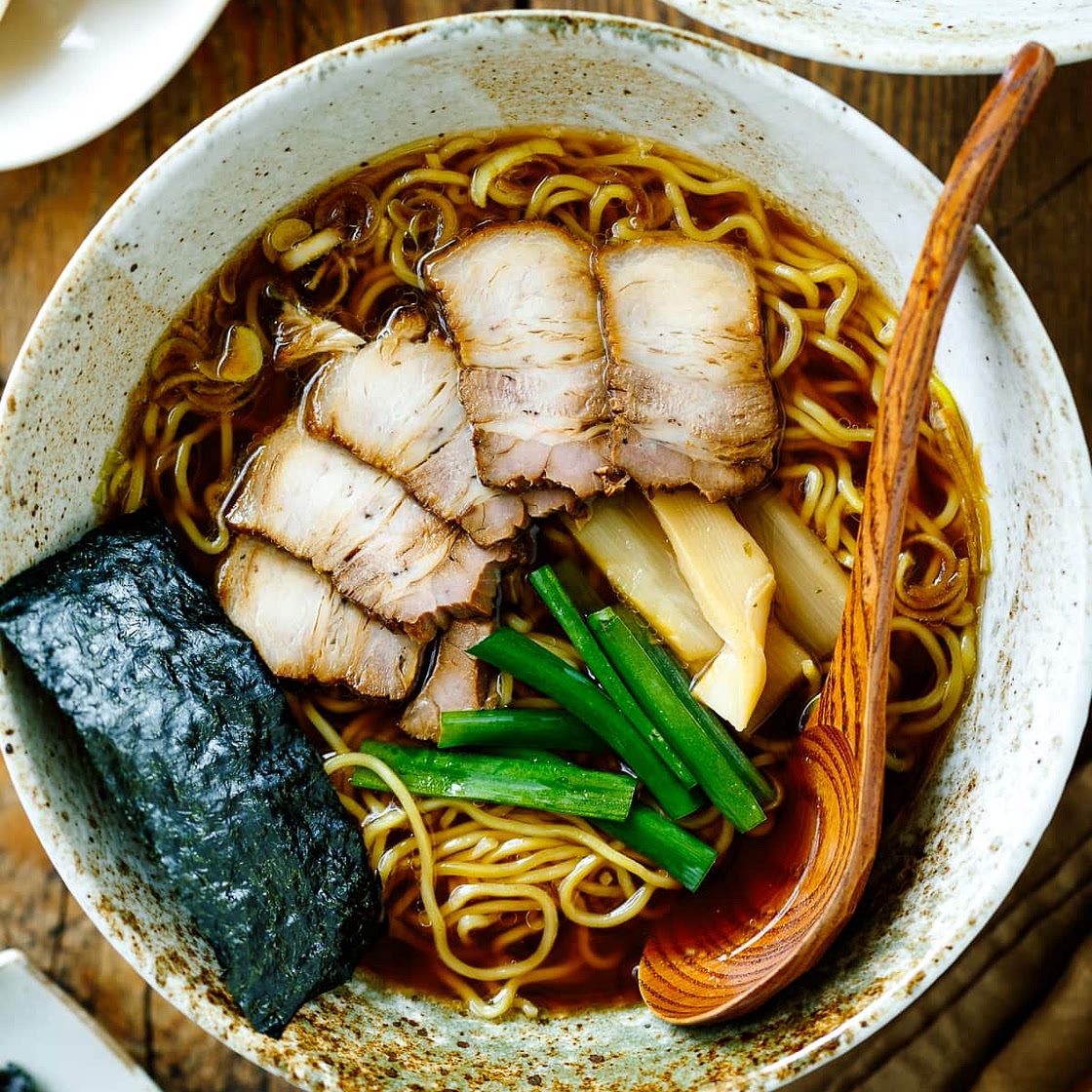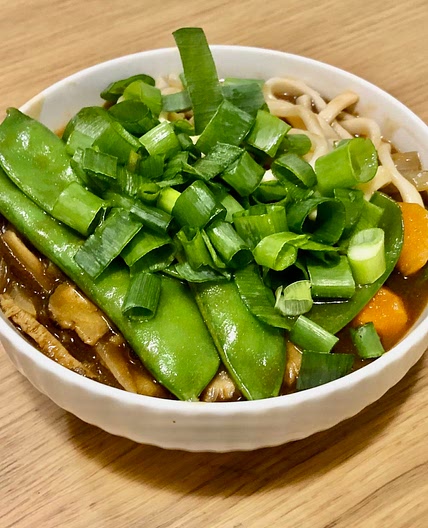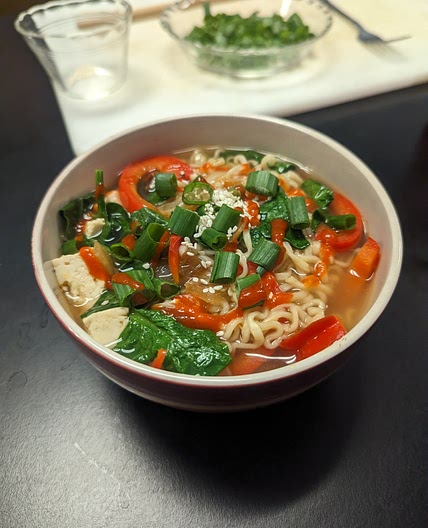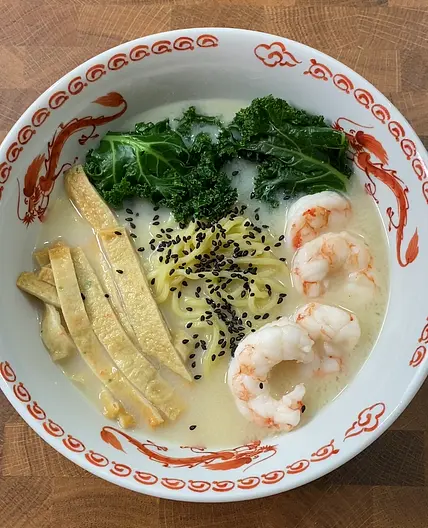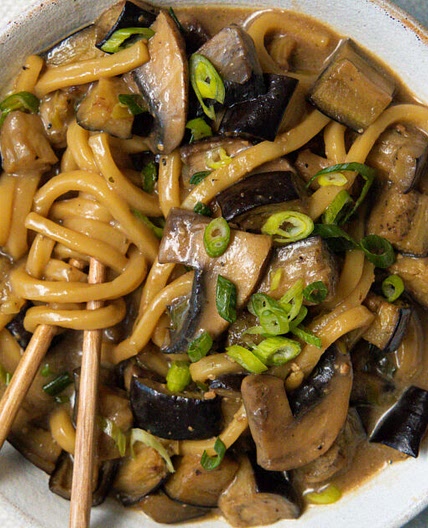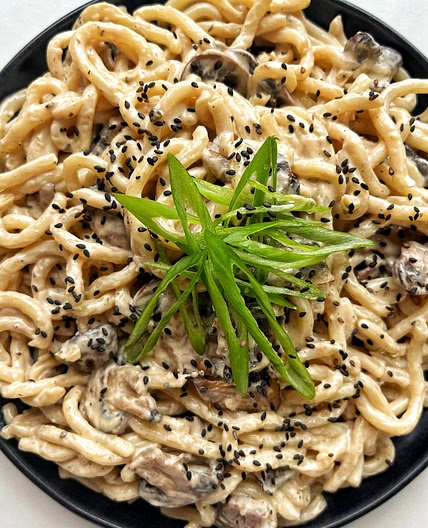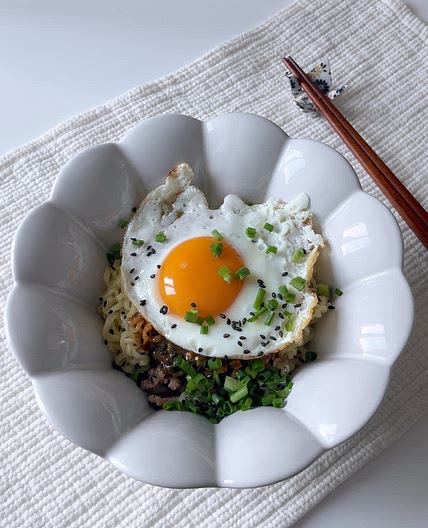By Wanderlust Flavors
Shoyu Ramen – Recipe from Bizentei, Tokyo 醤油ラーメン
47 steps
Prep:8hCook:6min
This comforting Shoyu Ramen is sheer perfection. Master Ueda of the famous Tokyo ramen shop Bizentei has generously shared his recipe that I’ve scaled here to a family-friendly portion. The slow-cooked, soy sauce-based broth extracts a deep flavor while the tender chashu (Japanese braised pork belly) simply melts in your mouth. Despite the long simmering time, the active cooking is just 30 minutes, so it‘s easy to make this authentic Tokyo-style ramen at home.
Updated at: Thu, 17 Aug 2023 03:43:14 GMT
Nutrition balance score
Uh-oh! We're unable to calculate nutrition for this recipe because some ingredients aren't recognized.
Ingredients
8 servings
For the Soup Broth
12 QTwater
1.33 lbspork leg bones
called genkotsu in Japanese, thigh bones, femur, and knuckles make a sweet, flavorful pork bone broth, found in the refrigerator section at H Mart or at a well-stocked butcher
0.5onion
large, skin on and trimmed of the root
5 clovesgarlic
skin on
1 knobginger
skin on, sliced
2 lbspork belly
2 long, narrow strips measuring 1 1/2 inches x 2 inches x 10 inches or 3.8 cm x 5 cm x 25 cm, found in the refrigerator section at H Mart or at a well-stocked butcher
3.5 ozchicken fat
rendered, you can get the shelf-stable type on Amazon or a refrigerated one from a grocery store
2Tokyo negi
naga negi, long green onion, divide into the green and white parts and used separately
For the Chashu (Japanese Braised Pork Belly) Sauce
For the Ramen
Instructions
To Start the Soup Broth and Chashu (at least 6 hours before serving)
Step 1
In a large stock pot, add the water, pork knee bones, onion, garlic, and ginger (DO NOT ADD the pork belly, chicken fat, and Tokyo negi yet).
Step 2
Turn on the heat to high and bring it to a boil. It takes 20–30 minutes for my stock to boil. You do not need to cover the pot with a lid.
Step 3
Meanwhile, tie up the pork belly with butcher twine to prevent it from falling apart. Run some butcher twine under the far end of the pork belly and tie the twine tightly in a double knot to secure it. Next, start wrapping the twine around the belly back toward the other end. Space each wrap ½ inch (1.3 cm) apart.
Step 4
Make sure you wrap the pork belly as tightly as possible without squeezing or deforming it. Once you reach the endpoint, run the twine under some of the end wraps; this hooks the twine in place. Tie a double knot and cut the excess twine.
Step 5
When the water starts to boil, skim off the foam and scum using a fine-mesh skimmer. Tip: I dip my skimmer in a measuring cup filled with water to clean the fine mesh.
Step 6
Gently add the pork belly to the soup broth. Set the timer and cook, uncovered, for 2 HOURS on high heat (or medium-high heat at first, if the soup broth is close to overboiling).
Step 7
Foam and scum will keep appearing on the surface as you cook down the soup broth, so keep skimming every now and then. Skimming is very important to get a clean and clear soup broth, so don’t let the scum incorporate into the broth.
Step 8
Some of the liquid will evaporate after a bit of time, making enough space for the additional water that I couldn’t add at the beginning. Here, I’m adding 1 QT (1 L) of water. It’s a small enough amount that the stock will return to a boil quickly. Keep cooking, uncovered, on high heat.
Step 9
10 minutes before the 2-hour mark, reserve 2 cups (480 ml) of the soup stock for making the chashu sauce. Then, if you have more space in the pot, add the last 1 QT (1 L) of water and keep cooking.
To Make the Chashu Sauce
Step 10
While the stock continues to cook, gather all the ingredients for the chashu sauce.
Step 11
In a large pot, add the reserved soup broth, soy sauce, sake, mirin, and salt and stir all together. Bring it to a simmer over medium heat. Once simmering, turn off the heat and set aside.
To Add the Chicken Fat to the Broth
Step 12
At the 2-hour mark, add the rendered chicken fat and green parts of the Tokyo negi (reserving the white parts to use later) to the stockpot. Now, set a new timer and cook, uncovered, for 1 HOUR on high heat.
To Braise the Chashu (2 Hours)
Step 13
When the 1-hour timer goes off at the 3-hour mark, use a pair of tongs to carefully and gently remove the pork belly from the soup broth and transfer it to a tray (or plate, to support the pork belly’s weight). The pork belly is extremely tender after cooking for a total of 3 hours.
Step 14
Transfer the pork belly into the large pot with the chashu sauce.
Step 15
Place an otoshibuta (drop lid) on top of the chashu and bring it to a simmer. To learn why we use an otoshibuta in Japanese cooking and how to make a DIY Otoshibuta with aluminum foil, see my post. You do not need to cover the pot with the pot‘s lid. Once simmering, cook for 2 hours on low heat or simmer.
To Simmer the Soup Broth
Step 16
After removing the pork belly, reduce the stockpot to low heat and continue to cook, uncovered. Set a new timer for 3 HOURS.
Finish the Chashu and Shoyu ”Tare”
Step 17
Once in a while, spoon the sauce over the pork belly as it’s extremely tender and hard to flip over without breaking it.
Step 18
After 2 hours of cooking the chashu, carefully and gently remove it from the sauce and transfer it to a tray (or plate).
Step 19
With a pair of scissors, cut and remove the butcher twine from the chashu. Try not to handle the chashu too much because it is super tender and can easily fall apart. If some of the meat sticks to the twine, very gently remove it so you don‘t pull off the meat. Cover the tray or plate with plastic and let cool completely. Then, chill the chashu well: Place it in the freezer for up to 1 hour until cold (but not frozen) if you‘re serving it right after the soup broth is made, in the refrigerator if you‘re serving later the same day, or in the refrigerator overnight to serve the following day. Make sure the chashu is cold and firm so it stays together when you thinly slice it; otherwise, it will fall apart.
Step 20
Skim the sauce to remove the fat and meat pieces. Transfer the sauce to a smaller pot. This salty sauce is called shoyu tare (sauce) and is the base for the ramen soup broth. It’s now ready to use. Alternatively, let it cool completely and refrigerate overnight to serve the following day.
To Finish the Soup Broth
Step 21
When the 3-hour timer rings, turn off the heat. You’ve now cooked the soup broth for a total of 6 hours (2 hours + 1 hour + 3 hours). Using a large fine-mesh strainer, remove the spent bones and aromatics from the broth and discard.
Step 22
Optional: I strain the soup broth one more time to yield a clean soup broth.
Step 23
The soup broth is now ready to use. Alternatively, you can let it cool completely and refrigerate overnight to serve the following day. If your stockpot doesn’t fit in the refrigerator, transfer the soup broth to a large pot before refrigerating.
To Prepare the Ramen
Step 24
Bring a big pot of water to a boil to cook the noodles. Meanwhile, gather all the ingredients (I show you 2 servings here). Then, heat the soup broth on medium heat until it’s piping hot; if you refrigerated your soup broth, remove the pot from the refrigerator and reheat.
Step 25
While you reheat the broth, prepare the ramen ingredients. First, cut the green parts off from the green onions. Cut the green leafy parts in half lengthwise.
Step 26
Cut the reserved white parts of the Tokyo negi in half widthwise. Then cut them in half lengthwise.
Step 27
Now, thinly slice the white parts of the Tokyo negi crosswise.
Step 28
Take out the chashu from the freezer or refrigerator. It should be cold and firm with the fat solidified when you slice it. Otherwise, the chashu will fall apart completely.
Step 29
Hold the chashu steady with one hand (I use a paper towel) and thinly slice it with a sharp knife, about ⅛ inch (3 mm) thick. As you slice, the pork fat will stick to the knife and make slicing difficult. When this happens, dip the knife in the hot soup broth to melt the fat off the knife. This is how Master Ueda does it and it’s very helpful. Tip: Slicing the chashu very thinly is key. When the delicate slices hit the hot soup broth, the succulent meat practically melts in your mouth.
To Cook the Noodles and Serve
Step 30
Before cooking the fresh noodles, loosen them up with your hands.
Step 31
Once the water in the big pot is boiling, add the noodles and cook according to the package instructions (typically, 60–90 seconds). While cooking, stir and separate the noodles with chopsticks. Here, I cook the noodles inside a big noodle strainer (I got it in Japan) that I’ve set inside the pot. Tip: I usually undercook my ramen noodles a bit so they are firm and toothsome
Step 32
During this short period of time, prepare the ramen bowls. To each bowl, add 1–2 Tbsp of shoyu tare and 1 Tbsp chopped white part of the Tokyo negi. Note: The shoyu tare is extremely salty, so start with 1 Tbsp and see how you like it.
Step 33
Pour 1½ cups (360 ml) of the piping-hot soup broth into each bowl. When the noodles are done cooking, drain them well in a strainer, shaking it a few times to drain the water thoroughly (otherwise, it will dilute the soup broth). Note: If your ramen bowl is bigger, you may need to add more tare and soup broth.
Step 34
Then, transfer the noodles to the individual ramen bowls. Lift up the noodles with chopsticks a few times to coat them with the soup broth and straighten them. Then, fold the noodles from the edge of the bowl and place them over the noodles in the soup for an attractive presentation.
Step 35
Quickly arrange the chashu slices, menma, green onions, and nori on top of the noodles. Serve immediately.
Notes
Step 36
Aromatics: Onion, garlic, ginger, and Tokyo negi (long green onion) – You can use green onions/scallions if you can’t find Tokyo negi.
Step 37
Ramen toppings: Green onions, menma (seasoned bamboo shoots), and nori (dried seaweed) – These are optional toppings.
Step 38
Pork bones – If you can’t find leg bones, use pork neck or spine bones. For the authentic flavor, it’s best to use the thigh bones (femur) and knuckles
Step 39
Rendered chicken fat – Please buy it online if you can’t find it locally. The flavor of the chicken fat in the soup broth is not something that we can easily substitute.
Summary Cooking Steps
Step 40
Start making the soup broth by simmering the pork leg bones, aromatics, and pork belly in the water for 2 hours.
Step 41
Right before the 2-hour mark, take out some of the soup broth and combine it with soy sauce, sake, mirin, and salt in another pot to make the chashu sauce.
Step 42
At the 2-hour mark, add the chicken fat and green parts of the long onions to the soup broth and cook for another hour.
Step 43
After a total of 3 hours of simmering the soup broth, take out the pork belly, and continue simmering the soup broth for the next 3 hours.
Step 44
Add the cooked pork belly to the chashu sauce and braise for 2 hours.
Step 45
After cooking for 2 hours, remove the chashu from the sauce and let cool completely before refrigerating (or freezing). Save this chashu sauce for the ramen’s shoyu tare (sauce).
Step 46
After a total of 6 hours of simmering the soup broth, remove the bones and aromatics, and the soup broth is ready.
Step 47
To serve, cut the chilled chashu into thin slices and cook the ramen noodles. Add the shoyu tare, piping-hot soup broth, and ramen noodles to the bowl. Top with ramen toppings of your choice and serve immediately.
Notes
0 liked
0 disliked
There are no notes yet. Be the first to share your experience!
